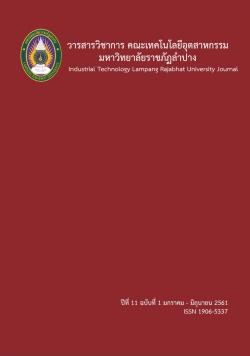An Implementation of Illuminance Meter Using Light Dependent Resistor Integrated with Labview Program
Keywords:
Lighting system, Light distribution, Illuminance meter, LDR, LabviewAbstract
This research presents design of illuminance meter by applying light. This research presents the design of an illuminance meter by applying a light dependent resistor (LDR) for light distribution testing. The luminance value is displayed on the Labview program. In order to calibrate the proposed illuminance meter, seven types of lamp were examined. A black testing room measuring 1.5m x 1.5m x 1.5m in size was constructed with steel structure and plywood. A stepping motor was used to rotate the light from -90 to +90 degrees in order to investigate the light distribution. The driver of the motor was controlled through the Labview program. The LDR was applied to measure the illuminance and the Labview program was used to display the value. The proposed illuminance meter was calibrated with a standard digital illuminance meter. The test was done five times for each type of lamp. According to the experiment, results showed that the proposed illuminance meter could measure at the range of 0- 900 lux. The average error was 4.42% with a standard deviation of 4.85. A high error occurred at low luminosity and it decreased when luminosity levels increased.
References
Haans, A. and Kort, Y.A.W. (2012). Light Distribution in Dynamic Street Lighting : Two Experimental Studies on Its Effects on Perceived Safety, Prospect, Concealment, and Escape. Journal of Environmental Psychology, 32, 342-352.
Hussein, E.A.R. (2013). Design and implementation of digital light meter. Journal of Babylon University, 21(1), 263-272.
Kulkarni, M.V. and Kulkarni, S.R. (2016). Measurement of light luminance and temperature monitoring for real time energy saving applications using Arduino Uno Atmega328. Bonfring International Journal of Research in Communication Engineering, 6(special), 34-37.
Kumar, N.P. and Jatoth, R.K. (2015). Development of cloud based light intensity monitoring system using raspberry Pi. International Conference on Industrial Instrumentation and Control (ICIC); May 28-30, 2015, Pune, India.
Ministry of Energy. (2010). Handbook of Personnel Responsible for Energy in Electrical Section. Bangkok: Ministry of Energy. (in Thai)
Ministry of Labour. (2011). Occupational Safety, Health and Environment Act A.D. 2011. Bangkok: Ministry of Labour. (in Thai)
Pornpojratanakul, V. (2006). Matlab Application for Lighting Distribution Analysis, M.S. Thesis, King Mongkut’s Institute of Technology Ladkrabang, Bangkok, Thailand.
Radhakrishnan, A. and Anand, V. (2013). Design of an intelligent and efficient light control system. International Journal of Computer Applications Technology and Research, 2(2), 117-120.
Thongchaisuratkrul, C. (2011). Energy Management in Buildings. Bangkok: King Mongkut’s University of Technology North Bangkok. (in Thai)






